Throughout the world it is common to find ceremonies in which the participants seek to renew the world, its resources, and thus continue their prosperity and good fortune. Among the Indians of Northern California—Karuk, Yurok, Hupa, Tolowa, Wiyot –the World Renewal or Big Time ceremony seeks to renew the world through a series of complex dances, speeches, and displays of high status items. The ceremonies are held to prevent sickness, to bring happiness, and to bring good weather. The death and rebirth of the world can be seen in the ceremonial rebuilding of ceremonial structures such as the sweathouse, ceremonial house, and dance areas.
With regard to the purpose of the World Renewal ceremony, Robert Heizer and Albert Elsassar, in their book The Natural World of California Indians, report:
“The purpose of the World Renewal ceremony was to prevent the occurrence in the coming year of disasters, such as earthquakes, failure of the salmon runs, failure of the acorn crop, floods, hurricanes, and the like.”
In an article reprinted in The California Indians: A Source Book, anthropologist A.L. Kroeber puts it this way:
“The esoteric magic and avowed purpose of the focal ceremonies comprising the system include reestablishment or firming of the earth, first-fruits observances, new fire, prevention of disease and calamity for another year or biennium.”
According to one Koruk elder:
“When man and the world become unbalanced, then we must dance the great dances, rhythmically stamping upon the earth, exchanging with it and balancing all that brings health, strength, food, honor, good luck, and happiness for all.”
The public portion of the World Renewal ceremony includes two dances: Jumping Dance (sometimes called the Jump Dance) and Deerskin Dance. Both of these dances provide an opportunity for the dancers to show their cultural wealth. A.L. Kroeber writes:
“The two dances gave the owners of the regalia their chief opportunity for public ostentation of treasures: they have accordingly been characterized as ‘wealth-displaying.’”
With regard to the Jumping Dance, dancers wear elaborate outfits, including headdresses with woodpecker scalps attached to the forehead band and topped with a feathered plume. Among the Yurok the participants wore a headdress containing about 70 redheaded woodpecker scalps. In addition to the headdress, the dancers also wear dentalia shell necklaces and a deerskin skirt and they carry a Jump Dance basket in the right hand.
Among the Hupa, each dancer carries a narrow cylindrical basket with is stuffed with straw. The basket is decorated with feathers and geometric designs.
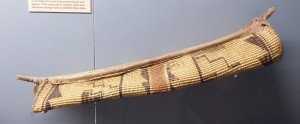
Shown above is a Yurok, Karok, or Hupa Jumping Dance basket which is on display in the Maryhill Museum of Art near Goldendale, Washington.
Jumping Dance baskets are made to be carried in the Jumping Dance ceremony and hold the medicine for the dance. This medicine is often based on a vision. In order to preserve the integrity of its contents, the basket is sewn shut. During the Jumping Dance ceremony, the power of the basket, the medicine in the basket, and the dancer merge. Basket collector Tim Ames, in an article in American Indian Art, reports:
“A Jump Dance basket created and used for ceremonial purposes was treated with the greatest respect and care.”
Once the Jump Dance basket is started, only the weaver can touch the basket. However, the basket is finished by a man, usually a member of the weaver’s family. Tim Ames writes:
“Once the man took over the finishing work, the weaver would not touch the basket again.”
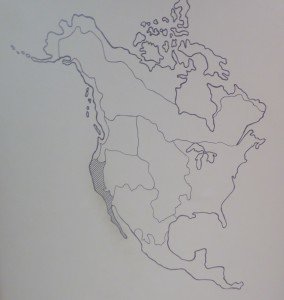
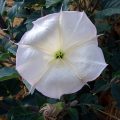
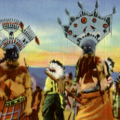
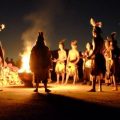
Leave a Reply